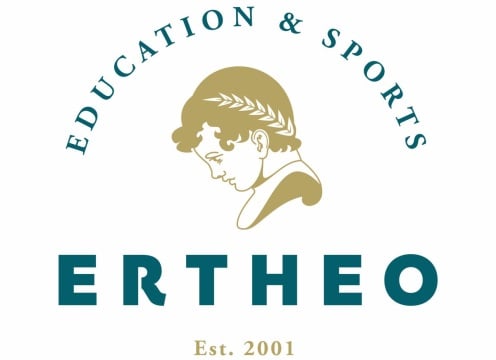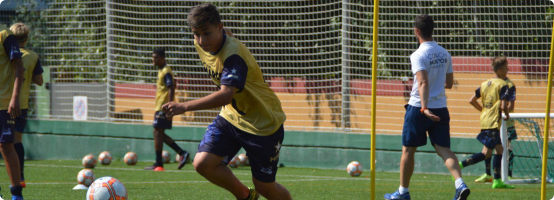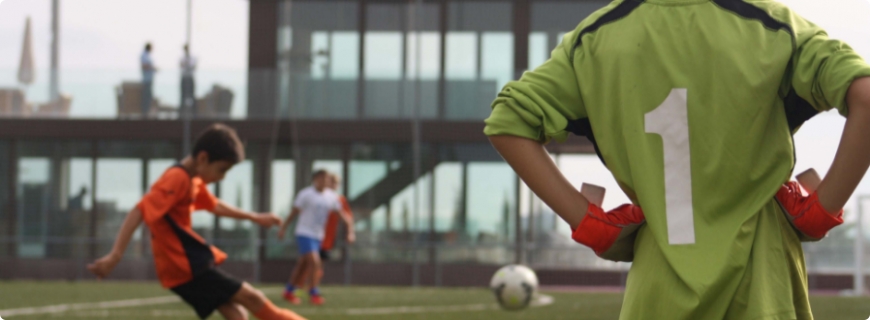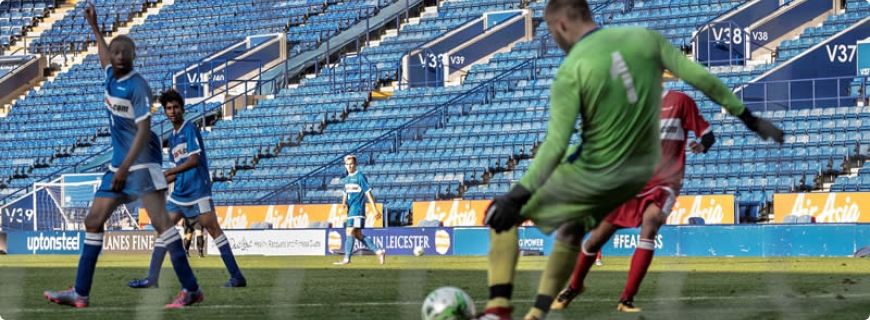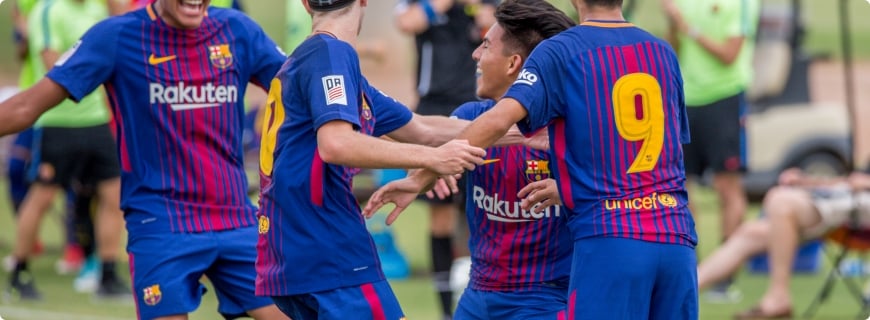Do you want to become a professional soccer player? You might have heard of high-performance soccer academies.
Soccer academies are boarding schools for elite, young soccer players designed to develop their skills and prepare them to compete at a collegiate, semi-professional, or professional level. The best academies not only have the connections and the know-how to help their students make it to the big leagues, but they also take education seriously and prepare their students for success in all areas of life.
High-performance soccer academies can be a great investment for a talented, young soccer player with big dreams.
That being said, not all soccer academies are equally as successful or provide the same opportunities for their students. While some have years of experience and hundreds of students enrolled in their programs as well as long lists of successful alumni, others are just small schools with empty promises. So, before enrolling in a high-performance soccer academy, it’s important to do some research to find out what you’re really signing up for.
At Ertheo, we created this complete guide to choosing a high-performance soccer academy to show you the many factors that distinguish a great high-performance academy from a mediocre one. After reading this guide, you should know more about high-performance soccer academies and how to choose the right one to help you reach your full potential.
Table Of Contents
- What are high-performance soccer academies?
- Why attend a soccer academy?
- The many kinds of soccer academies
- How to attend a high-performance academy
- Coaches’ qualifications and experience
- Types of training
- Comprehensive formation
- Connections and proven success
- Academic policy and education options
- Security, supervision, and healthcare
- Student life
- The best high-performance soccer academies
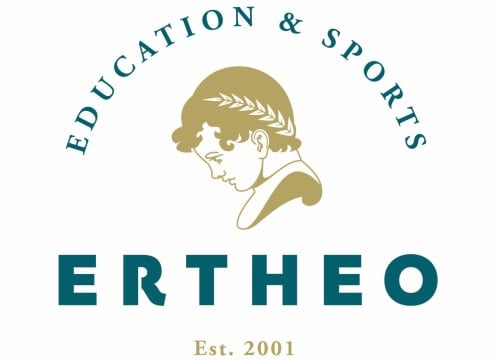
Prefer to read this article later?
Total read time: 25 minutes
1. What are high-performance soccer academies?
High-performance soccer academies are residential soccer schools that offer intensive, full-year, professional soccer player development programs. Students live, train, and study as they work to improve their performance and achieve their goals as both students and athletes.
Programs often include intensive field training, competitive tournaments and friendly matches, video analysis, physical conditioning, and workshops and classes about strategy and tactics. Students at high-performance academies may also learn about nutrition, injury prevention, rest and recovery, sports psychology, leadership, and more during the program.
Coaches at the best high-performance academies are not only UEFA certified but also have years of experience coaching collegiate, semi-professional or professional teams. Some are even ex-pros.
The best programs are designed to prepare talented and dedicated student-athletes to achieve their athletic goals while continuing their education. Many academies offer numerous education options for their students as well as private tutors to make sure they’re not only performing on the field but also in the classroom. Some even demand that all their students be in good academic standing to partake in training and/or compete in matches.
The best high-performance academies offer student-athletes the chance to develop their skills without neglecting their education.
Take a look at some of the main features of a great high-performance academy program:
- Ages accepted: 12 – 21 years old
- Level of play: Advanced – Elite
- Program duration: Full academic year (shorter programs also available)
- Objective: Preparation to play at a collegiate, semi-professional, or professional level
- Training program: Comprehensive, professional style training program to prepare players for all aspects of life as a professional soccer player
- Coaches: UEFA certified, knowledgeable, well-connected coaches with experience playing and coaching in the professional arena
- Education:Many education options available; private tutors; requires students to be in good academic standing
- Tuition: For the full academic year, tuition generally ranges from 25,000€ to 75,000€ and depends on a number of factors
2. Why attend a high-performance soccer academy?
Many talented, young soccer players dream about playing professionally, but they face numerous obstacles that can prevent them from achieving their goal. Some of the most common obstacles include ignorance (they don’t know how to make it to the pros), time (they’ve only got a small window or opportunity to develop their talent), and of course, mediocre coaching and training. Not to mention, they’ve also got school to worry about where they’re surrounded by distractions of all kinds.
Save it for later
High-performance soccer academies were created to remove those obstacles to give talented and dedicated student-athletes the opportunity they deserve to be successful. They provide talented young athletes with the ideal environment to achieve success where they’re surrounded by like-minded student-athlete who share their mission and focus.
Common obstacles to going pro include:
- Finding the balance between sport and education to excel in both areas
- Lack of knowledge about how to make it to the pros
- Coaches who don’t know how to put them in touch with scouts and professional teams
- Training at a low level where they’re one of the best in the league leaving little room for improvement
- An environment that doesn’t support their passion and mission
At the best high-performance academies:
- A school especially designed to meet the athletic and educational needs of elite student-athletes
- Personalized advice about their best options to advance their career
- Well-connected and knowledgeable coaches who can get them in front of professional teams and scouts
- High level training where they’ll be competing with and against the best student-athletes in the world
- Inspiration and motivation from other students who share the same focus and ambition
Whether success means competing at the collegiate level, semi-professionally, or professionally, high-performance soccer academies can provide talented, young soccer players with their best chance of achieving their goals. That being said, not all soccer academies provide their students with the same opportunities. In the next chapter we’ll talk about the many kinds of high-performance academies and what makes some better than others.
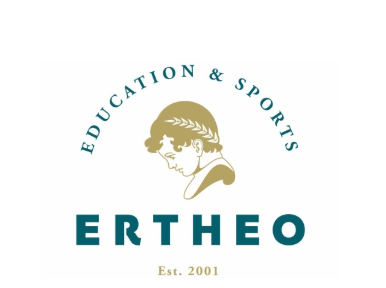
Do you want to reach your full potential as an athlete and student?
Let us help you find the right soccer academy for you.
3. The many kinds of soccer academies
Although most soccer academies share the same general objective of preparing their students to be successful soccer players, not all share the same values, philosophy, or methodology to lead their students to success.
For example, the High-performance Academy in Barcelona considers themselves worldwide pioneers in football education. As such, they are dedicated to employing the latest technology in their training programs. The training program at the High-performance Academy in Barcelona is strict, designed to teach students the importance of work ethic, focus, and integrity. They’ve got over 30 years of experience and a long list of alumni who have signed with professional clubs.
The FC Barcelona High-performance Soccer Academy in Arizona, USA, on the other hand, teaches according to FC Barcelona’s style of play and works in partnership with the United States Soccer Development Academy to prepare students to compete at the collegiate level or try out for the FC Barcelona reserve teams in Spain. Their strongest selling point is that every graduate has earned a college scholarship or signed a professional contract.
You might have noticed that while the High-performance Academy is located in Barcelona, it’s not affiliated to the FC Barcelona Football Club or any football club for that matter. Likewise, the FC Barcelona High-performance Soccer Academy is affiliated with the famous football club but is located in Arizona, USA.
While some are affiliated with official football clubs, others aren’t affiliated with any club teams at all. Affiliation with a club team isn’t necessarily a good thing (or a bad thing), but it is important to understand the difference between club team academies, academies with affiliations or agreements with club teams, and academies with no affiliation whatsoever. Each kind comes with its own advantages and disadvantages.
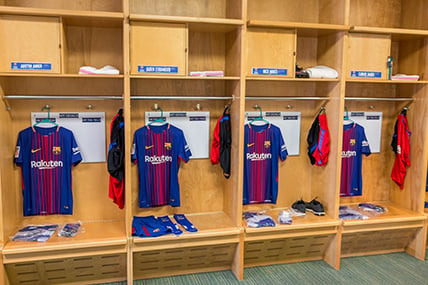
Official club team youth academies
In the United States, the high school and collegiate education systems are responsible for developing athletic talent. In Europe and Latin America, the education system doesn’t develop athletic talent. Rather, official clubs (both soccer and basketball clubs) create youth academies as a way to invest in young, talented athletes so they can use them in their first team in the future.
One of the most important things to understand about official club team youth academies is that each child is an investment for the club. The academies receive funding from the club and fund their own students. That’s why it’s usually not so expensive to join.
The only problem is that very few of these players actually make it to the first team (about 1%). And, of that 1% that is able to sign a professional contract with the club at age 16, five out of six of them are released before the age of 21.
So why do academies invest in so many young players if they know that 99% of them won’t make it to the first team? Because at the end of the day, buying a top player is a lot more expensive than funding 100 youth players at a soccer academy. So, if one out of every hundred students can make it to the first team, the club gets a good return on their investment. The other 99% of hopeful students are let go without any advice for moving forward, neither academically nor in their careers as footballers.
At the end of the day, the great majority of official club team youth academies treat their students like investments. Their primary goal is to make money off their investments, not to make sure that each child is well-advised about their options for going pro and advancing their career. That being said, some official club team youth academies are high-quality academies that truly care about the well-being and education of their students as well as developing their skills on the soccer field.
Taking all that into account, it’s important to do your research and find out whether the academy is really trustworthy and has the students’ best interest in mind.
High-performance academies with affiliations to club teams
There are also high-performance academies that don’t belong to a specific club team but are affiliated with them. These academies are privately owned and have their own objectives for their students. That means, the academy, not the football club ultimately decides their students’ fate.
That being said, academies can work with club as affiliates in a number of ways. For example, they can teach according to the club’s philosophy and send their best players to the club for trials and tryouts. Some club teams even send their official coaches to the academy to coach and scout out the best players.
The FC Porto High-performance Academy in Valencia, Spain is a good example of a soccer academy with a club agreement. The academy teaches according to FC Porto methodology. Coaches at the academy are provided for by FC Porto. The best players at the academy have the opportunity to try out for the FC Porto reserve team. And, to top it all off, the FC Porto first team uses the soccer academy’s state-of-the-art training facility and five-star residence to train while on the road.
The key difference between an official club team youth academy and a high-performance academy with a club agreement is that the official youth academy can sell players to other clubs and make money off them. This means they usually make decisions according to the club’s best interest. A high-performance academy with a club affiliation can help the student sign with their affiliate club, but since the academy can’t make any money off the student, they only make decisions according to the student’s best interest.
High-performance academies with no affiliation
There are also high-performance soccer academies with no affiliation to any soccer clubs. Some of the best academies in the world, like the Barcelona High-performance Academy have absolutely no affiliation to any soccer clubs. Rather, they rely completely on their reputation and connections to make sure all their students have the best opportunities possible.
Some of the Barcelona High-performance Academy alumni include:
- Keylor Navas, Real Madrid goalkeeper
- Oliver Torres, central midfielder for Portuguese club FC Porto
- Konrad de la Fuente, an American soccer player who plays as a winger for FC Barcelona Juvenil A
Students come from all over the world to the Barcelona High-performance Academy to train with professional coaches and receive personalized, unbiased advice about their absolute best options to advance their football career.
While there are many other high-performance academies all over the world with a similar mission, it’s difficult to find one with the same impeccable reputation.
At Ertheo, we’ve researched and visited countless soccer academies to determine the best, most reliable options for student-athletes to reach their full potential as both athletes and students.
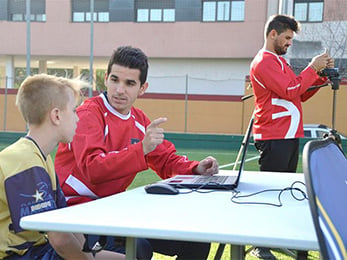
Check out our recommendations for high-performance soccer academies:
- Barcelona High-performance Soccer Academy
- High-performance Soccer Academy of Stamford, England
- FC Porto High-performance Academy in Valencia, Spain
- FC Barcelona High-performance Academy in Arizona, USA
4. How to attend a high-performance academy
If you’re thinking about attending a high-performance academy as a full-time student, there are two important factors to consider: requirements to attend and cost. This section talks all about how to attend a high-performance academy including the types of entrance trials available for students and the pros and cons of each entrance trial. Cost is another important factor in determining whether or not attending a soccer academy is a good option for you.
Save it for later
Requirements to attend
Students typically need to attend a trial or a tryout to be accepted into a high-performance academy as a full-time student. Options include camps, weekly trials during the academic year, or day trials. In the exceptional case that a player cannot attend a trial, sometimes academies consider accepting video applications.
Each academy has a unique entrance and enrollment process. Here’s a basic overview of your options:
Option 1: Attend a camp organized by the academy during the summer months, Easter holiday, or Christmas holiday.
- + All participants at these camps arrive at the same time and are new to the academy
- + Participants learn the philosophy and methodology of the academy and also get to know the coaches.
- – Participants don’t exactly experience life as full-time academy students during camp.
Option 2: Attend a weekly trial (or more than one week) during the academic year and train alongside full-time academy students.
- + Participants experience the full academy experience and get to know exactly what life would be like as a full-time academy student.
- + This program is much more personalized than the camp programs since there are fewer participants.
- – Participants train with a group of players who already know each other and must adapt.
Option 3: Try out for the academy on one of their trial days.
These trials last for 24, 48, or 72 hours. Candidates travel with their families to the academy to be examined by the coaches. They also attend a personal interview with the academy’s professionals so that parents can clear up any doubts that they might have about the program, get to know the personnel, and visit the facilities.
Option 4: Mail your application to the academy. Application must include:
- Letter of motivation and objectives
- Sports curriculum
- Reference letter
- Video of the player during match play
Cost
Full year academy programs can cost anywhere from 25,000€ to 75,000€ per year. The cost of the program highly depends on the country where the academy is located. Typically, payment plans are available so you don’t have to pay for the full cost of the program in one single payment.

Want to learn more about how to attend a high-performance academy?
Send us a message. We’d be happy to help.
5. Coaches’ qualifications and experience
Now that we’ve discussed some of the basics about soccer academies – what they are, why students attend, the many kinds of academies, and how to attend – it’s time to get into more specific details that can help you choose a soccer academy. One of the first things to consider when determining the quality of a soccer academy is the coaches’ qualifications and experience.
To rise to the top, a player needs coaches who are not only good teachers and mentors, but who also have experience coaching at an advanced or, preferably, professional level. That’s because players who are looking to make it to the professional leagues need more than just skill to achieve their goal. They need to learn about the system and what it takes to move up. And, more often than not, they need some connections to make their dream a reality.
Coaches with top coaching licenses and experience coaching semi-professional or professional teams have the knowledge, experience, and connections that young players need to learn about their options for advancing in the system. In addition, many coaches with top coaching licenses like the UEFA Pro License have played professionally themselves which means they know exactly what it takes to make it to the pros.
The High-performance Academy in Barcelona has an exemplary coaching staff of top-licensed coaches with experience playing professionally. Their staff includes Carlos Rivero – UEFA Pro License holder, ex-professional footballer for Real Madrid, and former FC Barcelona soccer coach, among many others with similar remarkable qualifications.
Investigating a coach’s coaching licenses is a good way to find out whether they have the experience necessary to help you get to where you want to go. So, it’s a good idea to learn about the various coaching licenses coaches can earn. That way, when you research coach qualifications at various soccer academies, you can determine which coaches are more qualified to help you advance in the system.
Coaching licenses in Europe
Soccer coaching licenses in Europe are distributed by the Union of European Football Associations (UEFA).
UEFA soccer coaching license progression is as follows:
- Level 1 – For recreational, grassroots soccer. Not mandatory but recommended. Time required to complete the course – A few weeks
- Level 2 (Certificate in Coaching Football) – For recreational soccer, soccer camps. Mandatory for some recreational leagues. Time required to complete the course – 6 months.
- Level 3, UEFA B License – For academies and centers of excellence. Mandatory for academies in Europe. Time required to complete the course – 12 to 18 months.
- Level 4, UEFA A License – For managing or coaching professional teams or academies. Time required to complete the course – 2 years.
- Level 5, UEFA Pro License – For managing in the FA Premier League and UEFA competitions and for coaching all major European first division teams. Time required to complete the course – 12 months.
To earn any official UEFA licenses (levels 3 – 5), coaches much first earn the Level 2 (Certificate in Coaching Football). After Level 2, each level builds upon the one before it. For example, coaches can’t obtain the UEFA A License without first having obtains the UEFA B License.
Coaching licenses in the USA
Two organizations oversee soccer coaching licenses in the US – the United States Soccer Federation (USSF) and the National Soccer Coaches Association of America (NSCAA). Both offer various certifications for different levels of play. However, their testing is slightly different and so are the prerequisites required for each certificate.
License progression for the USSF is as follows:
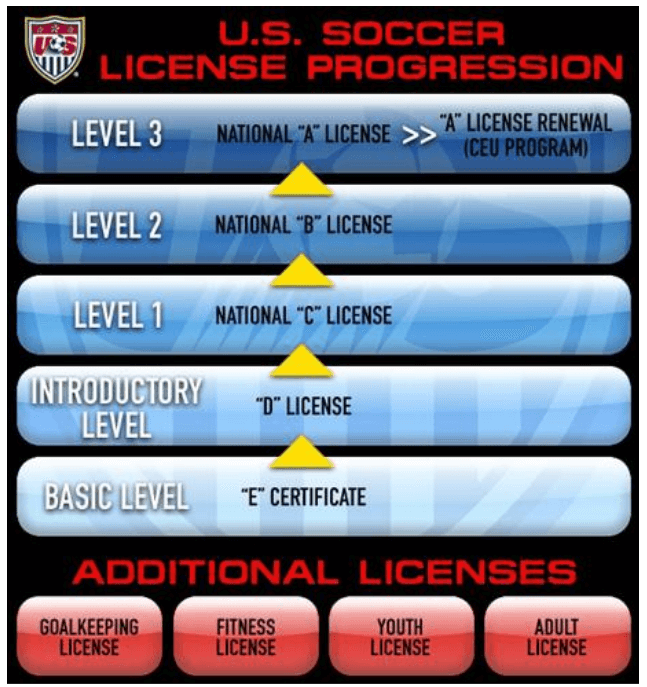
Source: Soccerpirrs.com
License progression for the NSCAA is as follows:
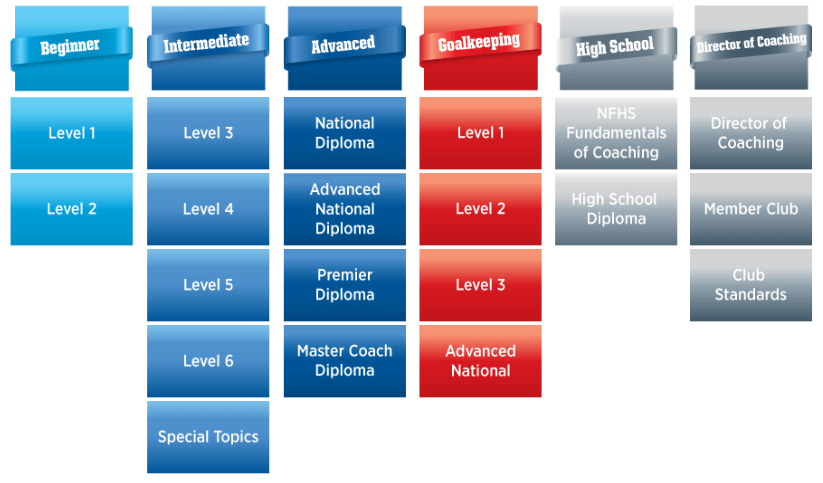
Source: Soccerpirrs.com
Coaches have to undergo hundreds of hours of coursework to qualify for top level coaching licenses. In most cases, the higher the level of their certificate, the more experience they have coaching and the more reliable and helpful their coaching will be.
When choosing a high-performance soccer academy, make sure you look up coaches’ qualifications so you can be sure to choose an academy where the coaches know how to help you rise to the top.

Do you dream about becoming a professional soccer player?
Let us help you find the right soccer academy for you.
6. Types of training
In general, the amount of hours and intensity level of the training at different soccer academies is quite similar. Students at high-performance academies are expected to be in top shape and ready to train intensely for up to 20 hours per week. That being said, training methodology, training facilities available to the students, technology, and competition opportunities can differ greatly from one academy to the next.
Save it for later
Training methodology
How students train at an academy is often called the academy’s methodology. If the academy is owned by an official club team or affiliated with one, the students will most likely train according to the club’s methodology.
For example, FC Barcelona is famous for their Tiki-taka style of play which is characterized by short passing, movement, and maintaining possession. Students at the FC Barcelona High-performance Academy in Arizona learn to play according to the same style. They also learn from FC Barcelona’s philosophy – More Than a Club – which recognizes the importance of complete player development. Students at the academy are taught that values like humility, ambition, effort, teamwork and respect are just as important as winning.
Likewise, FC Porto is famous for their training method called Tactical Periodization where players learn according to four critical “moments of the game” – offensive organization, defensive organization, transition from attack to defend, and transition from defense to attack. Therefore, students at the FC Porto High-performance Academy in Valencia learn and train according to the same methodology.
Training methodology can also include other coaching philosophies like “If you emphasize only team play, you’re inhibiting individual creativity and ability” or “The best offense is a good defense”.
All-in-all, it’s hard to determine which philosophy is the best or which will benefit you the most in the long run. Nevertheless, it’s important to research the training methodology of the academies you’re interested in to get a better idea of the kind of player you’ll become while training there.
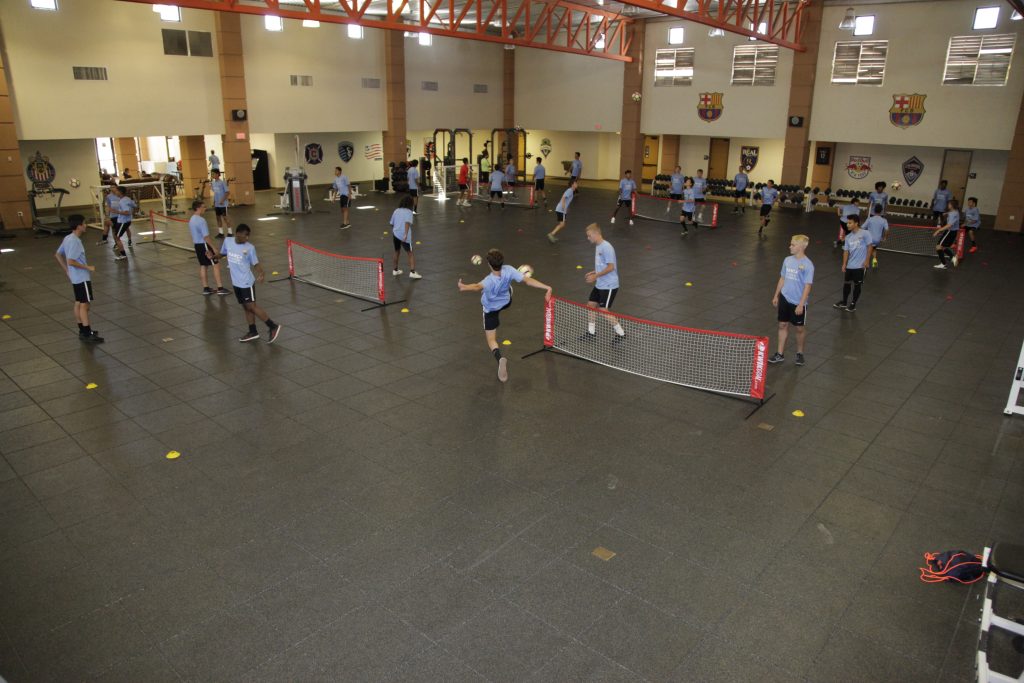
Training facilities available
When researching academies, it’s also a good idea to take a look at the different training facilities available to the students. The best academies will provide their students with a number of natural and artificial turf fields as well as a gymnasium, a swimming pool, plunge pools, a treatment and rehabilitation center, etc.
Technology at the academies
In the past decade, technology has had a significant impact on sports training and competitions. In soccer, new technology is currently being used for injury prevention, in training to improve skills more efficiently, in competition to have an advantage over the opponent, and in post match/practice analysis. As more clubs and academies implement this technology into their training methodology, the use of technology becomes more important for clubs and academies to stay ahead of the competition.
It’s a good idea to learn more about the different kinds of soccer technology available so that you know what to look for when choosing a soccer academy. Here’s a basic description of some of the most popular soccer technology:
Wearable technology for measuring individual performance – Wearable vests containing GPS trackers that allow a coach to “fully understand the physical impact on the body, including work rate, stamina, speed, distance, performance efficiency and, for the first time, the power of every player, in every position,” according to Adidas. Wearables can help prevent injury, help coaches compares players’ playing styles, and analyze and help adjust for a player’s unique strengths and weaknesses.
Equipment and machines for fitness and rehabilitation – New equipment such as spirometers ( an apparatus for measuring the volume of air inspired and expired by the lungs) and blood lactate analysers provide clear concise data regarding the physical fitness and condition of players. Likewise, Isokinetic machines are used to test muscle function and strength in soccer players and can be useful in predicting muscle injuries and muscle imbalances where one leg is stronger than the other. They can also help detect differences between various muscle groups in the same leg (hamstrings and quadriceps).
Training equipment for improving technique – Clubs and academies are also making use of new equipment used for training players and improving their individual technique. One such example is the “Footbonaut”, a high-tech training cage that simulates the technical skill needed in a real game such as passing, ball control, spatial awareness, and vision.
When you’re researching different soccer academies, make sure that staying up-to-date with the latest technology and implementing it in training is part of the academy’s agenda.
Look for statements like the ones below:
“Implementing the use of New Technologies in football training has been one of the Barcelona High-performance Academy’s major ventures for years. Using state-of-the-art equipment in training sessions is a fundamental requirement when it comes to learning football intelligently.”
“The FC Porto High-performance Academy uses the most advanced software to analyze our player’s performance. By providing our players with media content we allow them to identify the game scenarios that we address during the training sessions, leading to a better understanding of the game and their roles.”
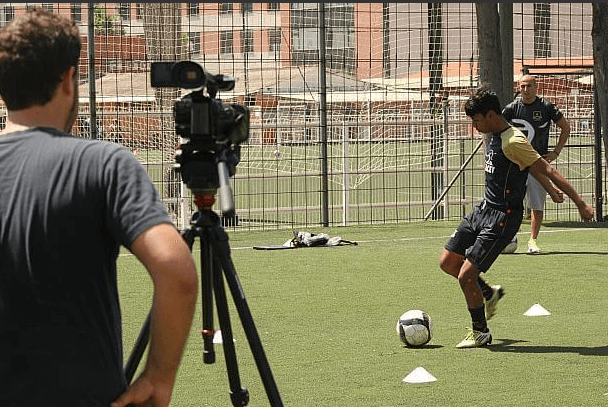
Competitions and trials
When researching training at various academies, you also want to take a look at the opportunities they provide for their students in terms of competitions and trials. Some academies feature heavy in-house competition where students compete in weekly friendly matches and tournaments against other students in the academy. Other academy teams compete in leagues against other club and academy teams. Some rely heavily on monthly international tournaments to give their students a chance to compete.
In general, a mix of all kinds of competition is the best option. Friendly matches are important so that coaches can stop the play and coach players to make better decisions. League competitions give students something to strive for – a common long term goal. And international tournaments expose players to all different styles of play and, of course, scouts from all over the world.
The only problem is that FIFA has many regulations in place that restrict international students under the age of 18 from participating in competitions outside of their home countries. At soccer academies, players under 18 years old are not allowed to participate in the national leagues until they either turn 18 or have stayed in the country for at least two years. This means that many academies have to rely on their connections and contacts to other academies and clubs to set up friendly competitions in order to give their players competition experience.
The Barcelona High-performance Academy, for example, is a big academy with a great reputation throughout Europe. As a result, they have many contacts and connections to clubs from all around the world and can provide their students with weekly matches and competitions.
Another example of a well-connected academy is the FC Porto High-performance Academy in Valencia. The academy has their own local team known as FC Porto Dragonforce, and national players can compete on the team in official league competitions. International players also have an advantage, however, because the academy uses their connections from their club team to organize weekly matches for their international students as well.
Smaller academies that are less reputable or with less students tend to have fewer connections and, therefore, can’t provide their students with as many competition opportunities.
It’s important to do your research and find out what kind of competition opportunities are available at the academies you’re interested in. And of course, don’t forget to research other aspects of their training including their methodology, facilities, and technology. That way you can be sure that you’re getting the best training possible during your time as an academy student.
7. Comprehensive formation
Playing soccer professionally sounds like a glorious day job, and it really can be. Many professional players earn fortune and fame and live amazing lives full of fulfilment and joy. But even the most successful players face obstacles and hardships that can be extremely stressful on both the body and the mind – often times, much more stressful than a typical day at the office.
Professional soccer players have to endure criticism from coaches, fans, newscasters, etc. They have to suffer through getting let go by teams or getting traded. They often have to move and live in other countries. And, they have to be able to manage their fortune and fame. Not to mention, they have to learn how to reintegrate into society as other kinds of professionals once their sports careers are over.
High-performance soccer academies are designed to prepare young soccer players to play professionally, which means they should do more than simply train them to have the technical and tactical skills they’ll need to impress scouts and clubs. The best soccer academies include comprehensive formation for their players where they teach them everything the need to know to live successful, healthy and happy lives as professional athletes.
Some important aspects of comprehensive formation offered at the best high-performance academies include health and nutrition education, rehabilitation and recovery formation, physiological guidance, leadership and role model formation, financial management, etc.
The FC Barcelona High-performance Academy talks about helping their students develop a growth mindset to ensure their professional development. The academy is “as committed to the development of the young athlete off the field as on the field.” They go on to explain that “a growth mindset is the foundation of fulfilling individual potential and the academy provides just that environment.” They teach communication mastery, life skills, community service, career building, and individual personal development.
Likewise, the FC Porto High-performance Academy in Valencia runs a “comprehensive and holistic player development program which seeks to improve all mental aspects of their athletes”. Sports psychologists at the academy help students manage stress and anxiety and build resilience. They also work on confidence, concentration, attention, focus, and leadership skills.
When researching high-performance academies, make sure they offer a comprehensive education designed to prepare students to live successful, healthy and happy lives as professional athletes.

Do you want to reach your full potential as an athlete and student?
Let us help you find the right soccer academy for you.
8. Connections and proven success
One of the greatest benefits of soccer academies is the many connections that they have to professional coaches, scouts, and club teams.
Coaches and scouts are constantly receiving emails, phone calls, video footage, etc. of players looking for the opportunity to try out for their club teams. Unfortunately, there are simply not enough hours in a day for them to pay attention to each and every request for a trial. They have to be smart about which requests they consider.
That’s why they rely heavily on their connections to find good players for them. Once they form a relationship with a youth coach or an academy, they trust that they won’t waste their time asking for trials for a player that isn’t worth watching.
That being said, coaches also have to be selective about the players they recommend to scouts and coaches in order to maintain their relationship of trust. So, connections won’t guarantee that you’ll get in front of scouts or professional coaches, but it will certainly be difficult to earn a trial without them.
Additionally, it’s very important for academy coaches to have contacts and connections at all levels. Academies should be able to offer their students the right opportunities according to their level of play. For example, if the player is only good enough to play in the 3rd division, the academy should be able to send them to a trial for a third division club team, not a first division team because the player obviously won’t make it.
If the academy only has connections to first division teams, many of their players will miss out on the opportunity to begin their careers at a lower level and work their way up. So connections at all levels are absolutely essential.
How can you research an academy’s connections?
Well-connected coaches
One of the best ways is to take a look at their coaches’ background. If coaches have either coached or played for professional club teams, it’s safe to say that they have strong connections with the club. Some coaches at soccer academies even double as both coaches and scouts.
One of the coaches at the High-performance Academy in Stamford, England is Ian Sampson. Sampson is both an academy coach and a Premier League Scout. He also played professionally for both Sunderland AFC and Northampton Town FC, which means he’s got many connections across England.
The Barcelona High-performance Academy also features an impressive staff. One of their coaches is Carlos Rivero. Rivero coached for FC Barcelona where he trained Lionel Messi. He has also coached first division teams in Greece and Argentina. And, he has experience as a professional footballer, having played for both Real Madrid and Boca Juniors. It’s safe to say that Rivero has important connections all around the world.
Successful Alumni
Another way to research an academies connections is by researching the academy’s alumni. Where did their students go after they graduated from the academy? Chances are good that wherever they went, the academy used their connections to help them get there.
Successful alumni at the Barcelona High-performance Academy include Keylor Navas – Real Madrid goalkeeper and Óliver Torres – FC Porto center midfielder. Likewise, the FC Barcelona Academy in Arizona has an amazing track record of students who earned scholarships to compete at top American universities like Stanford, Georgetown, and UCLA.
The connections at an academy can be the difference between leaving the academy with a plan to make your dreams a reality and returning home with no idea what to do next.
Connections at official club team youth academies
At this point, you might be wondering if the best way to end up playing for your favorite football club is by starting out in their youth academy. If your favorite team is Manchester United, wouldn’t Manchester United’s youth academy have the best connections with the club? The answer is yes, but it might not be the best idea to join their youth academy.
Remember, official club team youth academies are owned by the clubs and receive all their funding from the club. This means the primary goal of Manchester United’s youth academy is to get a return on their investment by bringing them up through the ranks to the first team.
But Manchester United is one of the most successful teams of the best league in England, and competition is fierce. Even if you manage to join their youth academy from a very young age, it’ll be very difficult to maintain your spot and earn a position on one of the their reserve teams.
Less than 1% of students at youth academies of official club teams actually make it to the first team. The rest are simply let go without any advice about how to move forward, neither academically nor in their football careers.
So, if your dream is to play for Manchester United, starting at their youth academy might not be the best way to make that dream a reality. It might be better to start your career at a high-performance academy that’s not owned by any club. That way, you can be sure that their advice to you is with your best interest in mind, and not theirs.

Do you dream of becoming a professional soccer player?
Let us help you find the right soccer academy for you.
9. Academic policy and education options
Education is one of the most important factors to research when choosing a high-performance soccer academy. It’s important to young, talented soccer players to fight for their dreams to play professionally, but it’s even more important for them to have a back-up plan in case their dream doesn’t play out the way they hoped.

At the end of the day, making a career out of professional soccer is extremely rare. Even for the players who manage to go pro, their careers are often short-lived. The average length of a professional soccer career is 8 years, and players typically reach their peak performance between 25 and 28. Not to mention, countless soccer players have even shorter careers due to unexpected injury at the worst possible time in their professional development.
That’s why a back-up plan and an academic education are absolutely necessary for lucky players and unlucky players alike. The lucky ones will need a plan for once they retire and the unlucky ones will need a plan for if they don’t make it to the big leagues or if they get injured.
Not every soccer academy considers education important
When researching soccer academies, it’s important to consider how much importance they place on education. Some academies treat education as an obstacle and a waste of time. They’d rather train their players for more hours a day than provide them with classroom and tutoring hours.
Other academies consider education to be of utmost importance. They provide their students with classroom hours and private tutors and even suspend their students from practices and competitions if they don’t perform in the classroom.
When researching soccer academies, make sure they have a clear plan for their students’ academic development. Make sure they provide tutors, classroom hours, and also that they care enough about their students’ education to discuss their academic performance with their students’ parents.
The FC Barcelona High-performance Academy in Arizona is a great example of a soccer academy with an excellent plan for academic development: “Through academic advising, directed study halls, college preparation, life skills support, community service opportunities, and stimulating cultural and extracurricular activities, the Academy provides our student athletes with the skills and capabilities they need to succeed in life.”
Make sure whatever academy you choose has a clear plan for their students’ academic development.
Common options for education at soccer academies
You might be wondering how education works at soccer academies – What education options are available? Does each academy have their own school, their own teachers, their own curriculum, etc.? Not exactly. Here’s are some common options for education at high-performance soccer academies.
- Enrollment in an online high school for student-athletes
Many accredited online high schools exist for the sole purpose of providing student-athletes with a way to continue their education while they participate in intensive training programs. Students enrolled in these online schools receive full credit for their studies and earn the same credits they would at a normal secondary school.
- Continuing to study at your current high school or university through distance education
Some secondary schools and universities offer their students the option to continue earning credits through distance education. They adhere to the same curriculum as the rest of the students but follow a special plan to complete their assignments from a distance. Options vary greatly from school to school. If you’re interested in this option, you should ask your school counselor if they offer any distance education options.
- Enrollment in courses offered by the academy or nearby educational institutions
Some students, especially older students from 18 – 21 years old, decide to enroll in courses offered by the academy or nearby educational institutions or universities. Various options may include sports management courses, sports coaching courses, language courses, and even college prep courses.
The best soccer academies will work with you to determine which education option is the right option for you. The right option for you will depend on your age and grade or academic level, the compatibility of education in your home country and destination country, distance education options provided by your current high school or university, and courses offered by the high-performance academy you’d like to attend.

Do you want to reach your full potential as an athlete and student?
Let us help you find the right soccer academy for you.
10. Security, supervision, and healthcare
Students at academies are typically between 12 and 21 years old with the average ages between 15 and 18. Security, supervision, and safety should be of utmost important to a soccer academy. When researching soccer academies, make sure all three areas are addressed and taken care of by the academy.
Security from outside threats
First and foremost, the academy should have security measures in place to protect their students from potential threats coming from outside the academy.
Security measures can include surveillance, security guards, on-site police officers, protective locks, access control protocols, security lighting and many other techniques. Security measures might also include emergency exit plans in the case of a fire or natural disasters that might occur in the area.
The best way to find out whether an academy is safe is to visit the academy yourself or talk to other students who have attended the academy.
It’s also a good idea to consider the academy’s location. Small towns in the countryside are usually safer than big cities. So, if the academy is located in a small town in a nice area like the High-performance Academy in Stamford, England, it’s probably a safe option.
Around the clock supervision
In addition, the best soccer academies make around the clock supervision a priority. As mentioned, students at academies are usually between 12 and 21 years old. Teenagers are very easily influenced by their peers and, therefore, more likely to get into trouble. Students at academies should be monitored and supervised at all times.
A good way to learn more about supervision at an academy is by investigating the monitor to student ratio. Look for less than 10 students per monitor. It’s difficult for any monitor to supervise more than 10 teenagers at once.
Likewise, the academy should have a strict code of conduct for their students including repercussions for breaking the code. When students understand that breaking the rules is met with consequences, they’re less likely to misbehave. Many academies will provide their students with some kind of handbook outlining the code of conduct. They might even have the students sign off that they’ve read the handbook.
Healthcare in the event of sickness or injury
Healthcare is the final piece of the puzzle. Students at soccer academies are training in highly competitive environments for up to 3 hours a day. Some students are going to get injured.
The best academies make sure their students receive high-quality health care in the event of injury or sickness. Many academies provide their own health care teams (medics, dentists, physical therapists, etc.) on-site for their students. Some academies, like the High-performance Academy in the UK, even provide all their students with private medical coverage.
It’s also a good idea to check the location of the nearest hospital to the academy in the event of an emergency. Some academies are located right next door to hospitals which can be very convenient for academy staff, students, and parents.
At the end of the day, students at soccer academies reside under the academy’s protection. The best soccer academies look out for the safety of their students and make sure they’re well-protected, well-supervised, and well-cared for in the event of sickness or injury.
11. Student life
The final factor you should consider when choosing a soccer academy is the student life there. Student life includes everything from accommodation arrangements, to eating schedules and meal plans, to strictness and rules at the academy, to extra facilities for enjoyment during free time, to weekend plans – all the factors that will affect your everyday life as a student.
Each of these factors can vary greatly from academy to academy, and whether you’re happy at an academy will have a lot to do with your personal preferences in these areas. Let’s take a look at how student life can differ from one academy to the next, so you can get a better idea of what kind of student life is right for you.
Accommodation options
Academy residences can range from traditional student dorms to hotels converted into residence halls. Additionally, sleeping arrangements can feature anywhere from 10 students to a room in military fashion – bunk beds, lockers, shared bathrooms, etc. – to private living where each student has their own bedroom, bathroom, desk, closet, etc.
Each scenario has its pros and cons. The military sleeping arrangement can be great for building camaraderie among teammates as they learn to tolerate each other, respect each other, and eventually build lifelong friendships. As a result, their chemistry and communication on the field improves and so does their desire to play their best for their teammates and friends.
Some students thrive in such communal environments; others need more privacy to feel their best and would feel more comfortable in private rooms or sharing a room with one or two other teammates. The important thing is to consider the differences and consider what environment would be a better option for your personal needs.
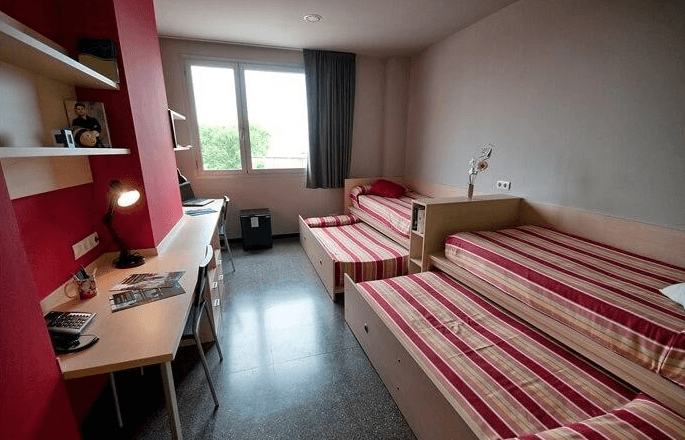
What, how, and when students eat
Academy food can affect your general overall happiness as much as accommodation arrangements can. More importantly, academy food can affect your health and sports performance. That’s why, when choosing a soccer academy, it’s important to learn what, how, and when students eat at the academy.
The best high-performance academies take nutrition seriously and hire sports dietitians to design quality meal plans for their students. The FC Porto High-performance Academy in Valencia provides a good example of a complete meal service for their students. Their plan includes:
- Prior evaluation of the anthropometric (body dimensions) and nutritional requirements of each player
- Guidance about the specific needs of each student
- Development of individual nutritional plans to prevent injuries
- Balanced menus and adequate hydration
- Advice on ergogenic (physical performance) supplement and support
Most high-performance academies feature buffet-style food service and a meal schedule so students can visit the dining hall during specific hours of the day. It’s a good idea to consider what kind of additional options the academy provides for food. Do they offer special vegetarian menus, gluten free menus, etc.? Another good question is what students can do if they are hungry outside of typical dining hall hours. Are there snack machines or shops the students can visit to buy food?
When choosing a high-performance soccer academy, make sure you investigate their meal services. You want to make sure the academy takes nutrition seriously and that they’ll be able to meet all your dietary needs during your stay.
Strictness and rules at the academy
Rules are absolutely essential for a high-performance academy to function and accomplish its objectives. That being said, some academies are much stricter than others.
Let’s take bedtime curfew as an example to see how strictness can vary at different academies. Some academies have a strict lights-out policy in which students must be in bed and silent with electronics off by a certain time of night. Such strictness can be very beneficial to the students. It ensures that the students get enough sleep each night and that they don’t disturb each other when they should be sleeping. These strict lights-out policies are almost necessary at academies where many students share the same dorm room.
Other academies have much more lenient policies. For example, they may expect students to be in their rooms by a certain time of night, but they might not demand silence or restrict the use of electronics. Again, such leniency has its advantages and disadvantages. Responsible students, or students used to a lot of freedom at home, might feel more comfortable in more lenient environments. That being said, such leniency can lead to more conflict amongst roommates who can’t agree on their own rules for successful cohabitation.
The level of strictness or leniency in an academy can apply to much more than bedtime curfews. Academies can have policies and rules for every aspect of academy life. What happens when a student is late to practice? When their grades are slipping? When they come into conflict with other students? Etc.
Some students are more successful in more lenient environments where they have more freedom. Others need stricter rules and policies to keep them on the straight and narrow. Whatever your needs, make sure you consider how strictness and rules at the academy can affect your everyday life as a student and your overall happiness.
All in all, when choosing a soccer academy, try to gather as much information as you can about student life there so you can form a clear picture in your head of what your life will be like as a student there.

Do you want to reach your full potential as an athlete and student?
Let us help you find the right soccer academy for you.
12. The best high-performance soccer academies
After reading sections one through eleven, you should have a better idea of what to look for when searching for a soccer academy.
There are many factors you should investigate to determine the quality of the academy and the likelihood that the academy will contribute to your success as an athlete. These factors include the coaches’ qualifications, types of training, comprehensive formation options for students, the academy’s connections and success record, their academic policy and education options, and their policies for security, supervision, and healthcare.
Likewise, you should investigate some key factors to determine whether or not you’ll be happy at the academy as a full time student. These factors include accommodation arrangements, food service available, strictness and rules at the academy, and anything else you can think of that will affect your everyday life as a student.
Ertheo’s selection of high-performance academies
It’s not always easy to find all this information readily available so you can determine your best options. That’s why, at Ertheo, we’re dedicated to researching soccer academies so we can find the best ones and present you with all the information you need to determine which academy is right for you. We visit different academies, talk to their staff including coaches, teachers, and monitors, and get feedback from full-time students at the academies and their parents to make sure the programs are reliable, safe, and effective.
Currently, we offer and endorse four high-performance academies throughout the world as high-quality options that can help talented, young soccer players reach their full potential as athletes, scholars, and people. You can read more about our selection below.
- Barcelona High-performance Soccer Academy
- High-performance Soccer Academy of Stamford, England
- FC Porto High-performance Academy in Valencia, Spain
- FC Barcelona High-performance Academy in Arizona, USA
While we might not have a complete list of the best academies in the world, we’re confident that these four academies are high-quality, trustworthy academies that can help provide high-performance soccer players with their best chance to be successful.
Interested in collaborating with Ertheo?
We’re always on the lookout for new high-quality academies and programs to offer and endorse, and we can offer many benefits for academies, clubs and agencies that would like to collaborate with us.
For clubs and academies, as long as we can visit your facilities and investigate all the conditions mentioned in this guide, we’re open to considering offering and endorsing your programs.
If you’re interested in collaborating with Ertheo, please feel free to contact us using the contact information provided at the end of this article. We’d be happy to discuss business with you.
Our selection of High-performance Soccer Academies
High performance football academy in Barcelona
The football academy in Barcelona is famous, especially in Spain, for producing professional soccer players using cutting-edge technology and methodologies. Students at the high performance soccer academy in Barcelona train all year round with coaches who have experience training and developing players into professional soccer players. This soccer school is strict with both training and education to ensure that students are prepared for their futures both on and off the pitch.
View complete academy description
High performance football academy in Valencia
Another outstanding high performance academy is located in Valencia and stands out for its excellent, top-of-the-line facilities and its match play program where students compete in games and tournaments against other teams almost every weekend. Thanks to their agreement with FC Porto, the soccer school uses periodization tactics, created by professor Vitor Frade, current manager of methodology at FC Porto.
View complete academy description
High Performance Soccer Academy UK
The high performance soccer academy in Stamford, England has a great reputation in the UK and abroad as a very professional academy where students experience what life would be like as professional soccer players. Coaches experienced in the English Premier League design and carry out intensive training sessions for the students. The academy provides flexible educational options to suit students of different ages and educational requirements.
View complete academy description
FC Barcelona High Performance Football Academy in the USA
FC Barcelona has partnered with the Grande Sports Academy in Arizona, USA to create the only U.S. soccer development academy program affiliated with a top international team. Students live, train, and study at the academy’s top-of-the-line facilities. Training follows FC Barcelona methodologies and even includes nutrition training. The FC Barcelona high performance soccer academy has many connections to college coaches in the US making it the perfect option for students who’d like to train and compete at a US university.
View complete academy description
Contact Information
Email: [email protected]
Phone numbers:
Spain (+34) 902 750 359
Spain (+34) 951 204 061
USA (+1) 857 208 72 49
UK (+44) 203 769 94 43
Mexico (+52) 554 160 44 95
You want to be the best?
With 15 years of experience, we know how to help you achieve your goals.
